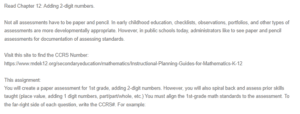Adding Two-Digit Numbers
Learning mathematics for 1st-grade learners requires the teacher to present a problem using words, numbers, pictures, and manipulatives. This way, the children extend their number facts and place value strategies to add within one-digit numbers. Van de Walle (2018) asserts that some skills children learn about place value adding one digit include understanding tens and ones, comparing numbers, and adding and subtracting within two-digit numbers. For example, students should be made to realize that a number like four can be made using the following ways: (4+0), (1+3), (2+2), (2+1+1) and (1+1+1+1). Therefore, teachers should ensure students have a solid foundation of numeracy, addition, and subtraction skills up to ten. Need help with your assignment ? Reach out to us. We offer excellent services.
| 4+0 1+3 2+2 2+1+1 1+1+1+1 The CCRS# in number 4=Ones |
A Paper Assessment for 1st Grade for Adding Two-Digit Numbers
A teacher-made worksheet is an example of a resource that can teach students addition questions and answers involving two-digit numbers. This resource is important in guiding students to master two-digit numbers together with their place value. The most common method that can be used in this case is the re-grouping method (Blöte et al., 2011). This involves guiding learners to combine two digits in terms of one, tens, and hundreds. The CCRS# when students have a question to identify place value in two-digit numbers like 24= tens24ones . The re-grouping method requires students to start by writing the two numbers vertically, within a line underneath. They can begin with the ones’ column on the right-hand side, add the two numbers (4 and 7), then carry the one over to the tens section, writing it above 2.
A Paper Assessment: Adding Two Digit Numbers
| 17 + 10 = | 11 + 15 = | 13 + 15 = | 10 + 18 = |
| 11 + 14 = | 26 + 17 = | 17 + 12 = | 18 + 11 = |
| 5 + 12 = | 25 + 14 = | 10 + 19 = | 12 + 11 = |
| 15 + 4 = | 10 + 10 = | 18 + 2 = | 15 + 22 = |
| 17 + 25 = | 16 + 13 = | 12 + 11 = | 19 + 17 = |
| 12 + 14 = | 13 + 13 = | 15 + 12 = | 16 + 19 = |
The teacher should guide learners in understanding how re-grouping works to avoid mistakes when adding numbers. To solve questions with re-grouping, learners should be taught how to group two-digit numbers by writing the equation vertically, where place values are lined up. For example, in the question (26+17), 6 in 26 represents ones, 2 represents tens, while 7 in 17 represents ones, and 1 represents tens.
References
Blöte, A. W., Van der Burg, E., & Klein, A. S. (2011). Students’ flexibility in solving two-digit addition and subtraction problems: Instruction effects. Journal of Educational Psychology, 93(3), 627.
Van de Walle, J. A., (2018). Teaching student-centered mathematics: Developmentally appropriate instruction for grades pre-K-2 (Volume I) (Vol. 1). Pearson.
ORDER A PLAGIARISM-FREE PAPER HERE
We’ll write everything from scratch
Question

Adding Two-Digit Numbers
Read Chapter 12: Adding 2-digit numbers.
Not all assessments have to be paper and pencil. In early childhood education, checklists, observations, portfolios, and other types of assessments are more developmentally appropriate. However, in public schools today, administrators like to see paper and pencil assessments for documentation of assessing standards.
Visit this site to find the CCRS Number:
https://www.mdek12.org/secondaryeducation/mathematics/Instructional-Planning-Guides-for-Mathematics-K-12
This assignment:
You will create a paper assessment for 1st grade, adding 2-digit numbers. However, you will also spiral back and assess prior skills taught (place value, adding 1 digit numbers, part/part/whole, etc.) You must align the 1st-grade math standards to the assessment. To the far-right side of each question, write the CCRS#. For example:
1. Which number is in the tens place? (1. NBT.2) 47
Book: ● (Van de Walle, J.A. (2018), Teaching Student-Centered Mathematics: Developmentally appropriate instruction for Grades PreK-2, (Vol 1) 3rd Edition; Pearson.

